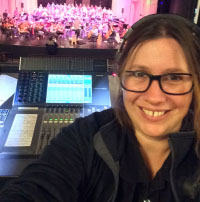In my previous article (here), I presented best practices for placing lavalier microphones in corporate event applications, and here I’m following up on the same topic in the theatre production market.
Miking the talent for a musical has many more considerations and possible pitfalls than “corporates,” so let’s take a look at what we should have in our kits, what to do when the job overlaps with other departments, and the all-important “selfie.”
First, a non-exhaustive collection of the supplies needed to help ensure that microphones stay in place while keeping the performers safe and healthy. These are all items taken from other applications to address the unique challenges faced by audio professionals working in theatre.
Shoe rack. Hang one (or two or three!) on a wardrobe rack to place mics and supplies such as tape, hair clips, and…
Unisolve. I love this stuff! Performers use it to clean adhesive residue off their skin. It’s moisturizing, unlike alcohol wipes which tend dry out skin, particularly over time.
Alcohol wipes. Wipe skin with them before placing mic tape. It cleans off excess oils and sweat that can cause tape to fall off mid-show.
Skin-prep protective wipes. Use them on clean, dry skin to create a sticky barrier for mic tape. This is especially effective for performers who “sweat off” their tape.
Bobby pins. These are great for pinning microphones to hair and clothing as needed. Make sure to open the pin up so that it doesn’t pinch the cable and cause damage.
Small wig clips. To keep the cable from flopping around an actor’s head, attach these clips to the cable with thread and secure them in their hair.
Hair colored yarn with matching texture. For headworn mics, wrap the mic with yarn that is a close approximation to the actor’s hair, which helps it blend in (and the design team will thank you).
3M Transpore clear plastic tape. The classic, go-to medical tape for theatrical miking.
3M Tegaderm transparent film dressing tape. This is perfectly clear, adheres better to sweaty skin than the Transpore tape, and does well with makeup.
Latex bodypack covers. These bags of loose condoms are an evolution in manufacturing for professional audio to protect bodypack transmitters from moisture. They’re not individually wrapped, which cuts down on waste and prep time.
Nitrile gloves. For particularly sweaty individuals, I place one of these over the top of the bodypack, run the antenna up one of the glove’s fingers, and then secure the glove in place at the bottom with a rubber band. This keeps sweat from dripping into the antenna and mic connections, which are still exposed when using only a bodypack cover. It also keeps the antennas from making direct contact with skin and causing drop outs.

Neoprene belt packs. Very common in modern theatre, these are made of wicking material and can be worn around the waist under costumes.
Hand sanitizer. Because we often touch performer faces and we’re always handling their sweaty, germ-laden mics. It shows the actors we work with that we care about their health and safety, and we need to help prevent the spread of illness in our companies.
Lysol spray. Gently spray the shoe rack once or twice a day.
Make A Plan
Approach miking performers with clinical efficiency and a good bedside manner. The first step towards this goal is to be well prepared with supplies on hand and a plan in place.
There are two go-to mic placements for theatre: in an actor’s hairline pointing down and on their cheek, with the bodypack transmitters generally secured to the waist. Standards eliminate complications and provide a starting point for any deviations. The simplicity of these placements allows most actors to secure their own mics, which frees up time to deal with the few who will need extra assistance.
So, why would an actor need help to clip on their transmitter and tape their mic? Well, sometimes things get complicated, which can mean placing the bodypack and mic in odd places. A few things that can impact where or how a mic is placed are hats or wigs, oddly shaped costumes, choreography like somersaults, extensive special effects makeup, onstage kissing, pies to the face, actors pushing their faces into the set or floor, and any other thing a designer or director thinks will serve the show.

Any of these things (and more) can make for creative mic placements, which means having a discussion with your department and any other department it will effect before going to the actor. It can be as simple as talking with the head of wardrobe about the best placement on a performer who has several quick costume changes or costumes designed to leave little to the imagination.
The Personal Approach
Making a great first impression counts for a lot. Before working with individuals, I try to address the entire cast at once. This guarantees everyone gets the most crucial information so I won’t have to repeat it 30 times.
The first thing I do is introduce myself and anyone else from the audio department. I give a quick overview of how the mics will be placed on them, and then point out where their mics will be on stage at call time, what time soundcheck will be, and ask them to please return the mics at the end of every show for fresh batteries.
I also talk about best practices for keeping the actors healthy. On a long run, putting tape over the same patch of skin day after day can cause skin irritation that can lead to much worse. I ask them to alternate their tape placement up or down an inch for every show, use the Unisolve to clean tape glue off and restore skin, and let me know if skin irritation occurs so we can address it.
I speak to them individually when physically placing their mics for the first time. I always ask their name first, and then the name of their character. I label the mics and shoe rack with both names, because on one production there was an actor named John who played a character named Nick and an actor named Nick who played a character named John.

I ask if they have any allergies or sensitivities to products we commonly use, like latex, adhesives, alcohol wipes, and wool. Latex allergies and sensitivities are far, far more common than most think. There might also be allergies I’ve never thought of and wouldn’t know about without asking.
The next part of this equation is to have a workaround for whatever they say. If an actor is extremely sensitive to alcohol wipes, I don’t want to run the mic down their cheek because the tape might not stick well. If they’re sensitive to latex, I use only nitrile gloves for them. Make sure to document any allergies mentioned and how they’re addressed. Next, I point out where they can find extra supplies in the shoe rack.
The last thing that must be done before actually securing the mic is to explain clearly what I want to do before I touch them, and ask if they’re OK with it. I start by explaining that the transmitter lives in the bodypack that will be secured to their waist. It’s important to note that many actors layer costumes in the name of efficiency. Secure the bodypack over the most interior layer of clothing that’s not removed during the show to avoid taking the pack on and off. Many actors wear an undershirt, but often the belt pack will go directly against their skin
I explain to them that the cable needs to run up the back of their neck to their forehead or cheek, and let them know that the next step is to tape the cable to the back of the neck, then either on the cheek and below the ear, or to the forehead. While I tape the cable in place, I ask actors to rotate their heads to make sure there’s enough slack so they have full range of motion. I don’t want a simple turn of the head to dislodge a mic!
When the mic is secured, ask each of them to take a selfie. Every night before putting their mic on, they check that photo as a reference for placement. This eliminates a significant amount of work for the A2 while demonstrating a level of trust not every actor has experienced.
Hot Swaps & Quick Changes
Here’s where all of the prep work pays off. Once the show is up and running, there may be one of those adrenaline-spiking moments where a mic needs to be hot-swapped. First, breathe. Timing is crucial here.
A stage performance rests on everyone’s backstage tracks flowing together like an elaborate dance.
Sometimes we have to change the pattern, so be aware of the best time and place to jump in. The stage right wing may be the best place to get an actor’s attention for a hot swap, but it might also have a set cart rolling through 30 seconds later. Be aware of everyone’s movements, not just your own, in order to minimize disruptions from malfunctioning mics.

Try to only replace the transmitter or the cable, depending on the issue. Find the path with the fewest costume layers, wigs, and pieces of tape between the faulty equipment and the new.
Finally, exhibit a calm demeanor with the actor. It’s unsettling when the A2 unexpectedly pops up out of nowhere and asks them to unzip their pants. They’re going to have a spike of adrenaline, too, especially if there is little time before they go back on stage. Help them stay calm by using your best bedside manner.
Those frantic moments of activity can be extremely tense and uncomfortable for everyone. If you’re not cool and collected, the actor may hesitate, which can cause a delay to the run of the show or the inability to fix whatever issue caused the hot swap to begin with. Having the reassuring demeanor of a nurse will mitigate these possibilities.
Speaking of the elephant in the room, there are going to be times when you will see them undressed. Sometimes you need to assist with a tricky costume change if the mic needs to be removed or replaced. Sometimes you’ll be down in the dressing rooms hiding a mic in someone’s hair.
These are definitely times to keep your opinions to yourself. Even if you think it’s a compliment, there is no reason to tell a performer what you think about their costume, makeup, and especially their body. More than being bad form, comments about another person’s physical appearance can be sexual harassment and can get you fired.
Finishing It Up
Finally, here some extra tips about interacting with actors that I’ve picked up along the way. Giving your opinion about individual performances will cause just as many problems as telling someone their costume washes out their skin. Even saying something you thought was nice about a performance can backfire – you just never know. And if they ask? Well, try to stay within the professional boundaries of a simple, “Good show!”

It’s important when discussing any technical issues with microphones that you offer answers. There are many fixes if an actor is sweating out, overloading, or consistently hitting their mic.
When you speak to them about a technical difficulty, be sure to make it about the mic, not their sweaty faces or acting. Try saying something along the lines of, “Excessive moisture is building up in the capsule causing it to stop working mid show, so we’ve decided to give you a headset to get the mic away from your skin.” This will put the “blame” directly on the shortcomings of the technology, and will keep them from feeling like they’re back in high school gym class.
Be aware that most people do not like having strangers touch them. Touching someone’s face, especially, is usually reserved for moments of intimacy. But as a theatrical A2, it’s literally part of the job. Be very clinical. Press tape down quickly and firmly without smashing your fingers into their faces.
This is a complex topic and YMMV. For maximum efficiency use these best practices as your starting place. And always have fun!




















